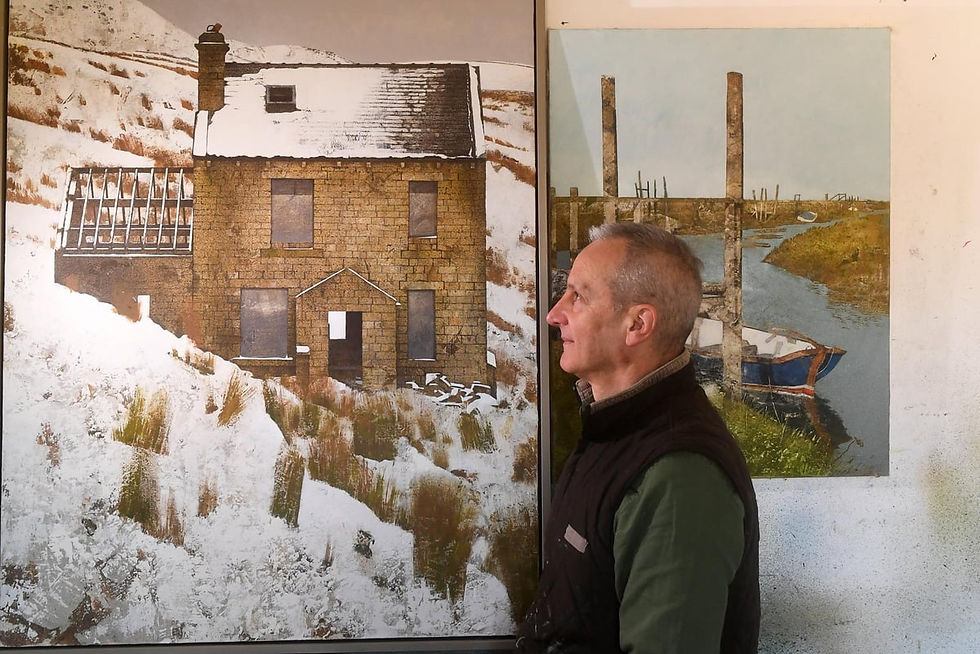Maxwell Doig : To New Shores
- Messum's Studio

- Apr 23
- 4 min read
Updated: Apr 24

“Across the water from Falmouth, at the village of Flushing, there is an amazing harbour wall. It was built by Dutch engineers three hundred years ago and it looks as solid as the day it was built. The long stones are stacked vertically and interlock in an intricate way. I haven’t seen anything quite like it. There is a sprinkling of orange lichen on the stones and you can see the tide lines across it. As soon as I saw the wall, I knew I had to paint it.” - Maxwell Doig
There is a quasi-surrealism that inhabits the paintings of Maxwell Doig which slowly reveals itself. Once the initial seduction has passed, you find yourself in a state of somnambulism, journeying backwards through your own memories - tracing days out in the country, summer holidays on the coast, or showery Saturday afternoons visiting relatives. This feeling of fragmentation is created by the unusual framing devices Doig often employs in his pictures. In this sense he is very Whistlerian in the structuring of his paintings and prints.
Like Whistler, he is not afraid to bisect the picture plane with strong verticals and horizontal elements, exaggerate the play of light and shadow close crop his subjects. As a photograph will capture elements of objects that extend outside the lens’ reach, these components provide us with a sense of what lies beyond the canvas. He has the ability to express a complete image in only a few dissonant notes, much like a fragmented memory, hence the feeling of distant familiarity in his work.

His own understanding of his subjects comes from close observation, from studying them in person, by water or by land, often camping out with them and coexisting in their own terrain. For his most recent collection of works he has turned his attention to the Devon and Cornwall coast, from Newton Ferrers to where the Percuil River meets the sea at St Mawes.
He was directed there in 2022 by David Messum who suggested that his particular painting style could liberate the Cornish light in a way that had previously been adapted to elucidating his Northern, post-industrial landscapes. It was new territory for Doig in more ways than one. Barring a brief trip as a child, the encounter with his Cornish subjects last summer was a new one. ‘It isn’t Northern at all!’ he reflected, comparing it to his home county. ‘Yorkshire is much danker and darker in tone.’ He had known full well of the artistic tradition of plein air painting associated with Cornwall but had not yet been quite ready to make the pilgrimage.
It seems he was not yet prepared for the intense clarity of the elements that make up the landscape and coastal scenery of this Area of Outstanding Natural Beauty, but he does not disappoint. His paintings of the quayside in Noss Mayo form stunning visual essays in how Doig is able to demonstrate the shifting narrative between the surface textures of stone, wood and water. They delicately balance with each picture being divided by the horizontal parallelism of the quay, broken up here and there by old tyres to offset the formalism.
This is also represented in his pictures of Newton Ferrers in which the hard graphic elements of the manmade structures are softened by the reflective surface of the water. It is apparent that Doig was drawn to these textures, and the relationship they share with one another, well before the clarity of light, sky and water revealed themselves to him. Textural and topographical accuracy are the details that make his pictures believable.
His Cornish and Devon subjects are a combination of his previous achievements on his painting trips to Flamborough, Whitby and Southwold. Now however, the architecture is not simply set in isolation, exposed to the sky, relying on the changing weather to dictate the mood. The temperament of these pictures is much more concerned with the built environment in direct communion with nature. As a result, the natural elements almost take on an architecture of their own. Doig moves seamlessly from water, to stone, to grass, to sky, perfectly demonstrating Doig’s ability to align hard-edged manmade geometry with the delicate elements of the natural landscape.
Accompanying Maxwell's 2025 exhibition was a new, fully illustrated catalogue which is available to buy on our website, as well as from our gallery in St. James's.
A new text by Patrick Duffy traces Maxwell's coastal journey from Cornwall and the Southwest, Dungeness in the Southeast, Southwold and Brancaster in East Anglia, and beyond to the Isles of Mull in Scotland. Pictures from every location demonstrate Maxwell’s consistent ability to relate their hidden histories.

Maxwell Doig : Press
"Artist Maxwell Doig moves his attention from Yorkshire to Cornwall in new London exhibition.
Huddersfield artist Maxwell Doig is well known for his paintings of derelict Yorkshire mills and buildings. But in his latest exhibition at the London's David Messum Fine Art gallery, his attention has turned to the Cornish and Devonshire coast."



























Comments